Abstract
In this work, the effect of pulse current and pulse duration in die-sinking electrical discharge machining (EDM) on the machining characteristics of Ti-6Al-4V alloy is studied. The EDM characteristics, including the electrode wear ratio (EWR), the material removal rate (MRR), and the surface roughness (SR), are used to measure the effect of machining. An increase in the intensity of the pulse current from 2.5 to 5 A produces a slow increase in EWR, MRR, and SR. An increase in the intensity of the pulse current from 5 to 7 A produces a rapid increase in EWR, MRR, and SR. Control charts are basic and powerful tools for controlling statistical processes and are widely used to monitor manufacturing processes and ensure good EDM quality. EWR, MRR, and SR are normal distributions, and the regression curves for the data are straight lines. All of the data points vary randomly around the centerline, which follows the Shewhart criteria and shows that the EDM process and product performance are under control and stable over time. After EDM, the surface exhibits an irregular fused structure, with pinholes, micro voids, globule debris, and many damaged surfaces. Oxygen plasma etching and surface modification after EDM reduce these surface defects, so finer and flatter surfaces can be achieved. Moreover, fatigue life can be enhanced.
Similar content being viewed by others
References
Lin MY, Tsao CC, Huang HH, Wu CY, Hsu CY (2015) Use of the grey-Taguchi method to optimise the micro-electrical discharge machining (micro-EDM) of Ti-6Al-4V alloy. Int J Comput Integr Manuf 28:569–576
Oliveira JA, Ribeiro SLM, Lauro CH, Brandao LC (2017) Analysis of the micro turning process in the Ti–6Al–4V titanium alloy. Int J Adv Manuf Technol 92:4009–4016
Gao P, Wang XB, Liang ZQ, Zhang SY, Zhou TF, Yan P, Jiao L (2017) Effects of machining inclination angles on microgroove quality in micro ball end milling of Ti–6Al–4V. Int J Adv Manuf Technol 92:2725–2734
Gong YD, Sun Y, Wen XL, Wang C, Gao Q (2017) Experimental study on surface integrity of Ti–6Al–4V machined by LS-WEDM. Int J Adv Manuf Technol 88:197–207
Alavi F, Jahan MP (2017) Optimization of process parameters in micro-EDM of Ti–6Al–4V based on full factorial design. Int J Adv Manuf Technol 92:167–187
Shabgard M, Khosrozadeh B (2017) Investigation of carbon nanotube added dielectric on the surface characteristics and machining performance of Ti–6Al–4V alloy in EDM process. J Manuf Process 25:212–219
Effertz PS, Quintino L, Infante V (2017) The optimization of process parameters for friction spot welded 7050-T76 aluminium alloy using a Taguchi orthogonal array. Int J Adv Manuf Technol 91:3683–3695
Deng JL (1989) Introduction to Grey system theory. J Grey Syst 1:1–24
Guo YF, Zhang GW, Wang L, Hu YH (2016) Optimization of parameters for EDM drilling of thermal-barrier-coated nickel superalloys using gray relational analysis method. Int J Adv Manuf Technol 83:1595–1605
Chiou AH, Tsao CC, Hsu CY (2015) A study of the machining characteristics of micro EDM milling and its improvement by electrode coating. Int J Adv Manuf Technol 78:1857–1864
Hsu HY, Hu CC (2017) Surface quality improvement of EDMed Ti–6Al–4V alloy using plasma etching and TiN coating. Int J Adv Manuf Technol 88:67–74
Azhiri RB, Teimouri R, Baboly MG, Leseman Z (2014) Application of Taguchi, ANFIS and grey relational analysis for studying, modeling and optimization of wire EDM process while using gaseous media. Int J Adv Manuf Technol 71:279–295
Quinino RC, Bessegato LF, Cruz FRB (2017) An attribute inspection control chart for process mean monitoring. Int J Adv Manuf Technol 90:2991–2999
Haridy S, Maged A, Kaytbay S, Araby S (2017) Effect of sample size on the performance of Shewhart control charts. Int J Adv Manuf Technol 90:1177–1185
Shamsuzzaman M, Khoo MBC, Haridy S, Alsyouf I (2016) An optimization design of the combined Shewhart-EWMA control charts. Int J Adv Manuf Technol 86:1627–1637
Kao JY, Tsao CC, Wang SS, Hsu CY (2010) Optimization of the EDM parameters on machining Ti–6Al–4V with multiple quality characteristics. Int J Adv Manuf Technol 47:395–402
Celano G, Castagliola P, Chakraborti S, Nenes G (2016) The performance of the Shewhart sign control chart for finite horizon processes. Int J Adv Manuf Technol 84:1497–1512
Park SH, Park CS, Kim JS, Baek JG (2017) Principal curve-based monitoring chart for anomaly detection of non-linear process signals. Int J Adv Manuf Technol 90:3523–3531
Sheu SH, Tai SH, Hsieh YT, Lin TC (2009) Monitoring process mean and variability with generally weighted moving average control charts. Comput Ind Eng 57:401–407
Guu YH, Hou MT (2007) Effect of machining parameters on surface textures in EDM of Fe-Mn-Al alloy. Mater Sci Eng A 466:61–67
Abbasi JA, Jahanzaib M, Azam M, Hussain S, Wasim A, Abbas M (2017) Effects of wire-cut EDM process parameters on surface roughness of HSLA steel. Int J Adv Manuf Technol 91:1867–1878
Khan MAR, Rahman MM (2017) Surface characteristics of Ti-5Al-2.5Sn in electrical discharge machining using negative polarity of electrode. Int J Adv Manuf Technol 92:1–13
Guo M, Diao D, Yang L, Fan X (2015) Restructured graphene sheets embedded carbon film by oxygen plasma etching and its tribological properties. Appl Surf Sci 357:771–776
Kaczorowski W, Batory D, Szymanski W, Niedzielski P (2015) Evaluation of the surface properties of PEEK substrate after two-step plasma modification: etching and deposition of DLC coatings. Surf Coat Technol 265:92–98
Yun DY, Choi WS, Park YS, Hong B (2008) Effect of H2 and O2 plasma etching treatment on the surface of diamond-like carbon thin film. Appl Surf Sci 254:7925–7928
Bagehorn S, Wehr J, Maier HJ (2017) Application of mechanical surface finishing processes for roughness reduction and fatigue improvement of additively manufactured Ti-6Al-4V parts. Int J Fatigue 102:135–142
Mower TM (2014) Degradation of titanium 6Al–4V fatigue strength due to electrical discharge machining. Int J Fatigue 64:84–96
Author information
Authors and Affiliations
Corresponding authors
Rights and permissions
About this article
Cite this article
Liang, J.F., Liao, Y.S., Kao, J.Y. et al. Study of the EDM performance to produce a stable process and surface modification. Int J Adv Manuf Technol 95, 1743–1750 (2018). https://doi.org/10.1007/s00170-017-1315-9
Received:
Accepted:
Published:
Issue Date:
DOI: https://doi.org/10.1007/s00170-017-1315-9



